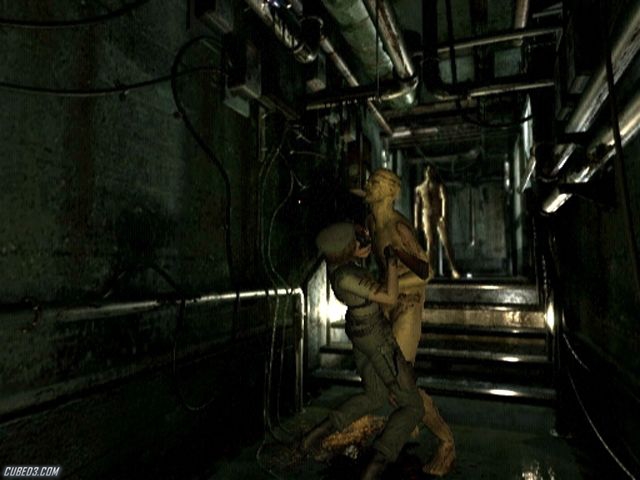Resident Evil Archives: Resident Evil (Wii) Review
By Adam Riley  08.09.2009
08.09.2009

The original Resident Evil has been ported and remade several times since its initial inception on the PlayStation back in 1996, with the GameCube seeing a visually spruced-up edition and even the humble Game Boy Advance getting in on the survival horror action. It is the last generation GC edition that is the source material for this latest Wii scare-fest, though, with almost no additions being made. Can a mere port of a 2002 remake be enough to entice Wii owners that missed out first time round to dip their toes into the bloody waters, now at a reasonable budget price?
There will undoubtedly be those out there that have yet to sample the original Resident Evil, or at least will not have tried out the GameCube remake that had something like 70%+ extra content thrown in to make it worth the purchase. Of course, since the GameCube did not fare quite as well as the PlayStation 2 or Xbox, you can kind of see why Capcom is giving this another airing on the far more popular Wii. Justification over. As for the story behind this gruesome game, the date is July 1998 and the setting is Raccoon City, a mid-western US town controlled by a pharmaceutical company by the name of Umbrella, Inc., that has been having some trouble with cannibalism near its forest. Rather than the local police checking out the situation, though, an elite group called the 'Special Tactics and Rescue Service' (S.T.A.R.S for short) is sent in, with its Alpha team staying back whilst the Bravo team head off to find out why there are zombies on the loose. After losing contact with Bravo, Alpha - including the likes of now well-known names such as Jill Valentine, Albert Wesker and Chris Redfield - lands nearby, only to be attacked by rabid dogs that seem impervious to gun fire. Entering what appears to be an abandoned mansion, the fear-filled adventure begins.

To start with, players choose whether to play through as Jill or Chris. Choosing the female lead gives a slightly simpler scenario to play through, with her carrying capacity being larger and certain extra items being made available, although her strength levels are much lower than Chris'. Whilst being able to carry more items may not seem like a massive advantage, it definitely plays a large factor in your survival since items can only be stored in special boxes found around the mansion, and cannot simply be dropped on the floor and collected later. With so much to discover on your travels, your inventory will soon be filled completely, which becomes somewhat of a nightmare when your ammunition bank runs out or health is getting quite low and there are supplies sat there right in front of you that cannot be picked up as there is no space left! Logically in real life you would put the new bullet cartridge straight in the empty gun, or use the First Aid spray to boost energy. Yet in Resident Evil such logic goes straight out the window. That is point of contention number one.
The second major issue stems from the awful control system, for two reasons. Rather than rework the set-up to take full advantage of the Wii console's infra-red pointing ability, Capcom has merely put a waggle effect in that makes Jill or Chris raise their fire-arm. However, it proves to be a highly frustrating mechanic due to its temperamental, twitchy nature leading to many instances of death in ever the simplest of situations. The best bet is to go with the other control options available - use the Wii Remote on its side, plug in a GameCube pad or use the Classic Controller attachment.

Now comes the other control-related bug-bear: the return of the tank-like movement. Resident Evil 4 was almost perfectly streamlined, with fluid movement and intelligent camera movement. However, back when Resident Evil was first conceived, pre-rendered backgrounds had to be used to instil a sense of foreboding and atmosphere that could only be achieved by using graphical prowess beyond the capability of the current platforms at that time. So the game consists of numerous gorgeously crafted static areas, where your character can awkwardly move around in (up and down move you forwards and backwards, whilst left and right slowly spin Jill or Chris on the spot in either direction) and once reaching a specific part of the screen, the camera will simply jump to the next pre-set image, totally messing up your perception and changing your characters orientation, leading to the player having to readjust how they were moving the character around. In instances where there is no intense action going on, then all is fine and dandy. Throw in a couple of blood-sucking zombies and then all hell lets loose, with unnecessary deaths caused by the total disorientation and times when you cannot even see what is coming at you as the enemy is out of the current camera angle coverage.
Thankfully the overall experience is such an enjoyable one that these two potentially game-breaking issues tend to fritter away into the background as the whole experience grips you tightly and does not let go until both campaigns have been completed. With impressive cut-scenes, general visuals that still rise above most of the third party drivel that plagues Wii, strong voice work that carries the story along nicely, as well as sound effects and music that will have you jumping out of your skin in many moments, there is absolutely no doubting how well presented this Capcom classic truly is.

As well as Resident Evil being an out-and-out survival horror title (unlike the more action-oriented Resident Evil 5 that left several fans with a strange taste in their mouths), players must bring their brains along for the ride, since there are some cunning puzzles draped across your path, many of which will have you scratching your head in puzzlement until something clicks and it all falls into place. These segments make for a nice change of pace from the blood-curdling cries of zombies lurching towards you, the seriously scary moments where enemies jump out at you unexpectedly or the adrenaline-filled times when facing off against a ridiculously tough boss character.
So all-in-all, Resident Evil Archives shows that the extra content and aesthetic improvements added to the GameCube remake of the original PSone classic were more than enough to keep its inner quality from shining through and overcoming the control and inventory flaws. If you are one of those that missed out on the GameCube version, then definitely check this out at its low price for a true taste of what Resident Evil is all about...

Cubed3 Rating
Very Good - Bronze Award

Anyone that picked this up on the GameCube should ignore Resident Evil Archives since it is, for all intents and purposes, the exact same game. However, considering the Wii installed ownership is far in advance of the humble GC, this is a perfect chance for those who missed out first time round to experience why the Resident Evil franchise is so revered. A true classic survival horror title that still manages to shine brightly in today's market...
Comments
Comments are currently disabled

 Sign In
Sign In Game Details
Game Details
 Out now
Out now  Out now
Out now  Out now
Out now  Out now
Out now  Subscribe to this topic
Subscribe to this topic Features
Features







 Top
Top

